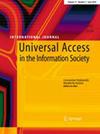Accessibility first: detecting frustration in web browsing for visually impaired and sighted smartphone users
IF 2.7
4区 计算机科学
Q3 COMPUTER SCIENCE, CYBERNETICS
引用次数: 0
Abstract
Abstract Smartphone adoption has become increasingly prevalent in modern society, reflecting the widespread integration of these devices into various aspects of daily life, yet accessibility and usability problems persist. Smartphones pose numerous challenges to individuals with visual impairments (VI). This is due to smaller screen sizes, lack of physical buttons, and prevalent problems. These challenges frustrate users as they are unable to accomplish their goals. In this paper, the physiological response of VI and sighted individuals are compared and examined. The participant's frustration is measured through physiological signals. The GSR is the signal captured to detect the user's frustration caused by the superimposed accessibility and usability web-related issues. GSR, being less obtrusive, is an effective way to measure frustration. There were 13 VI and 16 sighted participants. Using a within-subject and between-subject design, participants completed four tasks, each was completed under frustrating and non-frustrating conditions while wearing an Empatica E4 wristband to collect GSR data. Challenges were both group-specific and mutual. A slowed internet connection and constant page refreshes are frustrating tasks for sighted participants. VI participants faced an unsearchable drop-down list and an inaccessible menu. Pop-up ads and session timeout are common tasks. Among VI participants, there was no significant difference between frustrating and non-frustrating tasks. When VI participants experienced a session timeout, they significantly showed a higher level of arousal. When comparing the physiological responses of sighted and VI participants in the page refresh and session timeout tasks, the results show that the arousal level is significantly higher in VI participants, primarily due to accessibility issues.无障碍第一:为视障和视力正常的智能手机用户检测网页浏览的挫败感
智能手机的采用在现代社会越来越普遍,反映了这些设备广泛融入日常生活的各个方面,但可访问性和可用性问题仍然存在。智能手机给视力受损的人带来了许多挑战。这是由于屏幕尺寸较小,缺乏物理按钮以及普遍存在的问题。这些挑战会让用户感到沮丧,因为他们无法完成自己的目标。本文比较和考察了视残者和正常人的生理反应。参与者的挫败感是通过生理信号来衡量的。GSR是捕获的信号,用于检测由叠加的可访问性和可用性网络相关问题引起的用户挫折感。GSR不那么突兀,是衡量挫败感的有效方法。有13名视力障碍者和16名视力障碍者。使用受试者内部和受试者之间的设计,参与者完成了四个任务,每个任务在令人沮丧和非令人沮丧的条件下完成,同时佩戴Empatica E4腕带收集GSR数据。挑战既有群体的,也有相互的。对于视力正常的参与者来说,缓慢的互联网连接和不断的页面刷新是令人沮丧的任务。VI参与者面对一个无法搜索的下拉列表和一个无法访问的菜单。弹出广告和会话超时是常见的任务。在VI参与者中,令人沮丧和非令人沮丧的任务之间没有显著差异。当VI参与者经历会话暂停时,他们显着表现出更高水平的唤醒。在页面刷新和会话超时任务的生理反应对比中,结果表明,VI参与者的唤醒水平明显更高,这主要是由于可访问性问题。
本文章由计算机程序翻译,如有差异,请以英文原文为准。
求助全文
约1分钟内获得全文
求助全文
来源期刊

Universal Access in the Information Society
COMPUTER SCIENCE, CYBERNETICS-
CiteScore
6.10
自引率
16.70%
发文量
81
审稿时长
>12 weeks
期刊介绍:
Universal Access in the Information Society (UAIS) is an international, interdisciplinary refereed journal that solicits original research contributions addressing the accessibility, usability, and, ultimately, acceptability of Information Society Technologies by anyone, anywhere, at anytime, and through any media and device. Universal access refers to the conscious and systematic effort to proactively apply principles, methods and tools of universal design order to develop Information Society Technologies that are accessible and usable by all citizens, including the very young and the elderly and people with different types of disabilities, thus avoiding the need for a posteriori adaptations or specialized design. The journal''s unique focus is on theoretical, methodological, and empirical research, of both technological and non-technological nature, that addresses equitable access and active participation of potentially all citizens in the information society.
 求助内容:
求助内容: 应助结果提醒方式:
应助结果提醒方式:


